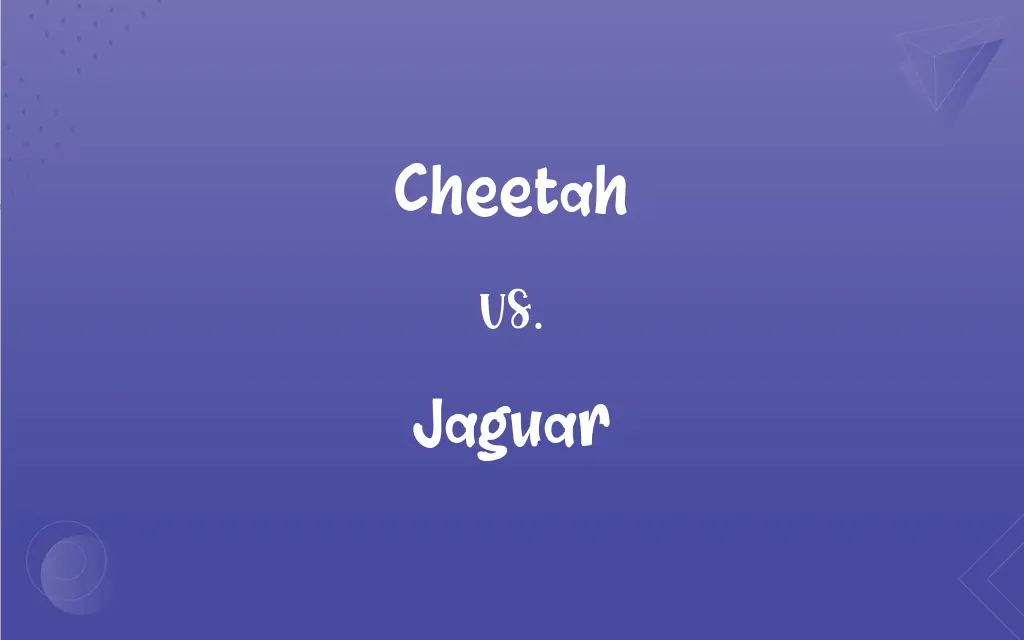Cheetah vs. Jaguar: What's the Difference?
Edited by Aimie Carlson || By Harlon Moss || Updated on July 1, 2024
Cheetahs, known for their incredible speed, have a slender body and distinctive “tear marks.” Jaguars, found in the Americas, are robust and recognized for their powerful build and rosette-patterned coat.

Key Differences
The cheetah, scientifically known as Acinonyx jubatus, is renowned for its remarkable speed, making it the fastest land animal on the planet. It possesses a slim, lightweight body, enabling it to reach speeds up to 60 miles per hour in mere seconds. Conversely, the jaguar, or Panthera onca, touts a notably powerful and sturdy physique, boasting a profound capability to swim. Unlike cheetahs, jaguars are not built for speed but for strength, proving themselves as formidable predators in their habitats.
Despite both being carnivorous predators, the hunting styles of the cheetah and jaguar differ significantly. A cheetah's hunting strategy is heavily reliant on its speed, utilizing rapid, short bursts of acceleration to chase down prey across open savannahs. Precise, sharp claws and a lightweight frame assist in quick, agile pursuits, leading to a successful hunt. Their slender build and long legs are characteristic features that facilitate their renowned speed.
In contrast, jaguars employ a starkly different approach, often ambushing or stalking their prey and utilizing their strong jaw and teeth to pierce through the skulls or shells of their catch. Their robust build and powerful muscles allow them to take down larger animals, demonstrating an impressive display of strength. Jaguars often pull their prey into the water to make it harder for them to escape, utilizing their adept swimming abilities to their advantage in hunts.
Comparison Chart
Physical Appearance
Slim, with tear marks
Robust, with rosette patterns
Habitat
Open savannahs in Africa
Rainforests in the Americas
ADVERTISEMENT
Hunting Style
Speed and chase
Strength and ambush
Swimming Ability
Generally avoid water
Excellent swimmers
Scientific Classification
Acinonyx jubatus
Panthera onca
Cheetah and Jaguar Definitions
Cheetah
In zoology, the cheetah is classified under the genus Acinonyx and is recognized for its slender, streamlined build.
Scientists often study the cheetah's physique to understand its remarkable speed.
Jaguar
The jaguar is a large, sturdy feline native to the Americas, recognized for its rosette-patterned coat.
Jaguars often use their powerful jaws to crush the skulls of their prey.
ADVERTISEMENT
Cheetah
Recognizable for its "tear marks," the cheetah has distinctive facial features unlike other big cats.
The cheetah’s tear marks are not only iconic but also functional in hunting.
Jaguar
Classified under the genus Panthera, the jaguar is the third-largest big cat species in the world.
Researchers acknowledge the jaguar as one of the most powerful big cats globally.
Cheetah
The cheetah, a specialized hunter, relies heavily on its sight and swiftness to hunt during the day.
Unlike many big cats, the cheetah hunts primarily during daylight hours.
Jaguar
In a geographical context, jaguars predominantly inhabit dense rainforests and are proficient swimmers.
The jaguar easily swam across the river, demonstrating its adept swimming abilities.
Cheetah
Cheetah populations are primarily found in sub-Saharan Africa, residing mainly in open savannahs.
Conservation efforts are underway to protect the dwindling cheetah populations in Africa.
Jaguar
Jaguars employ a hunting style that primarily utilizes their strength, often ambushing and overpowering their prey.
The jaguar silently stalked its prey before pouncing with immense power.
Cheetah
The cheetah is a large African wild cat known for its incredible speed and agility.
The cheetah effortlessly outran its prey across the savannah.
Jaguar
In terms of conservation, jaguars are listed as near-threatened, facing threats from habitat loss and human activities.
Conservationists are working to establish protected areas for jaguars to roam freely.
Cheetah
A long-legged, swift-running wild cat (Acinonyx jubatus) of Africa and southwest Asia, having tawny, black-spotted fur and nonretractile claws. The cheetah, the fastest animal on land, can run for short distances at about 96 kilometers (60 miles) per hour.
Jaguar
A large feline mammal (Panthera onca) of Mexico, Central America, and South America, closely related to the leopard and having a tawny coat spotted with black rosettes.
Cheetah
A distinctive member (Acinonyx jubatus) of the cat family, slightly smaller than the leopard, but with proportionately longer limbs and a smaller head; native to Africa and southeast Asia (where it is nearly extinct) and also credited with being the fastest terrestrial animal.
Jaguar
A carnivorous spotted large cat native to South and Central America, Panthera onca.
Cheetah
A species of leopard (Cynælurus jubatus) tamed and used for hunting in India. The woolly cheetah of South Africa is Cynælurus laneus. It runs very fast in short spurts while hunting.
Jaguar
A large and powerful feline animal (Panthera onca, formerly Felis onca), ranging from Texas and Mexico to Patagonia. It is usually brownish yellow, with large, dark, somewhat angular rings, each generally inclosing one or two dark spots. It is chiefly arboreal in its habits. It is also called the panther and the American tiger.
Cheetah
Long-legged spotted cat of Africa and southwestern Asia having nonretractile claws; the swiftest mammal; can be trained to run down game
Jaguar
A large spotted feline of tropical America similar to the leopard; in some classifications considered a member of the genus Felis
FAQs
Where are cheetahs primarily found?
Cheetahs primarily inhabit various parts of sub-Saharan Africa.
Are cheetahs good climbers?
Cheetahs are not known for climbing and generally stay on the ground.
Where are jaguars mainly located?
Jaguars predominantly reside in the rainforests of the Americas, especially in the Amazon Basin.
How is the jaguar’s coat pattern described?
Jaguars have a coat patterned with rosettes, which are larger and have smaller spots inside them.
What is a key feature of the jaguar’s hunting style?
Jaguars often employ a strategy of ambushing prey, using their powerful bite to pierce through skulls or shells.
Are jaguars adept at swimming?
Yes, jaguars are proficient swimmers and often hunt in water.
Is the jaguar the largest big cat in the Americas?
Yes, the jaguar is the largest big cat native to the Americas.
How long can a cheetah maintain its top speed?
A cheetah can maintain its top speed for short bursts, typically around 20-30 seconds.
How do cheetahs and jaguars differ in physical build?
Cheetahs are slender and built for speed, while jaguars are robust and built for power.
Which is larger, a cheetah or a jaguar?
Jaguars are larger and heavier than cheetahs.
Do jaguars and cheetahs climb trees?
Jaguars can climb trees to store prey away from other predators, while cheetahs rarely climb.
What distinctive facial feature do cheetahs have?
Cheetahs have black "tear marks" running from the eyes down to the sides of their mouth.
What is the top speed a cheetah can reach?
Cheetahs can reach speeds up to 60-70 miles per hour.
What time of day do cheetahs usually hunt?
Cheetahs typically hunt during the day, primarily in the early morning or late afternoon.
What is the conservation status of jaguars?
Jaguars are listed as near-threatened, mainly due to habitat loss and poaching.
How do cheetahs kill their prey?
Cheetahs use their speed to chase prey and typically aim for the throat to suffocate it.
What type of habitats do cheetahs prefer?
Cheetahs typically prefer open savannahs where they can utilize their speed.
What is the primary diet of jaguars?
Jaguars have a varied diet, consuming over 85 species, including deer, capybara, and sometimes caimans.
How can you visually differentiate a cheetah from a jaguar?
Cheetahs have tear marks and a slender frame, while jaguars have larger rosettes and a sturdier build.
Are cheetah populations stable?
Cheetah populations are declining due to habitat loss, human conflict, and illegal wildlife trade and are currently listed as vulnerable.
About Author
Written by
Harlon MossHarlon is a seasoned quality moderator and accomplished content writer for Difference Wiki. An alumnus of the prestigious University of California, he earned his degree in Computer Science. Leveraging his academic background, Harlon brings a meticulous and informed perspective to his work, ensuring content accuracy and excellence.
Edited by
Aimie CarlsonAimie Carlson, holding a master's degree in English literature, is a fervent English language enthusiast. She lends her writing talents to Difference Wiki, a prominent website that specializes in comparisons, offering readers insightful analyses that both captivate and inform.































































